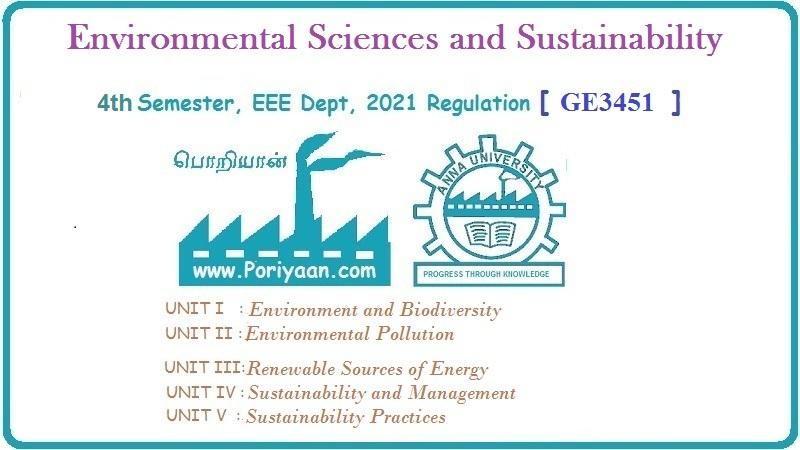Environmental Sciences and Sustainability: Unit I: Environment and Biodiversity
Energy Flow in Ecosystem
• The energy needed for the function of ecosystems comes from an external source, the sun. The solar energy is transformed into chemical energy by using photo-synthesis. This chemical energy is nothing but carbohydrates and oxygen.
Energy Flow in Ecosystem
•
The energy needed for the function of ecosystems comes from an external source,
the sun. The solar energy is transformed into chemical energy by using
photo-synthesis. This chemical energy is nothing but carbohydrates and oxygen.
Photosynthesis
equation

•
A part of chemical energy is utilized by the producers (plants) for their
growth and remaining energy is transferred to consumers.
•
The decomposer utilizes the energy with consumer producing inorganic nutrient.
This nutrient is again used by producer to produce food for consumer. Fig.
1.6.1 shows flow of energy and nutrients.

Nutrient
cycle
•
The producers use nutrients for preparing food and which is consumed by consumers
and then decomposer recover the nutrients from consumer.
•
Therefore, nutrients flow between biotic and abiotic components repeatedly, it
is called as nutrient cycle or biogeochemical cycle.
1. Biogeochemical Cycle
•
In an ecosystem the cycling of nutrient involves both biotic and abiotic
components. The biogeochemical cycle involves
1.
Hydrological cycle (Water cycle).
2.
Oxygen cycle.
3.
Nitrogen cycle.
4.
Carbon cycle.
5.
Phosphorous cycle.
2. Relationship between Structure and Function or Flow Model
•
In an ecosystem the biotic components and abiotic components are linked
together energy flow and nutrient cycling.

3. Hydrological Cycle
•
The hydrological cycle is continuous movement of water between surface of earth
and atmosphere. The hydrological (water) cycle involves a dynamic balance
between the two processes of evaporation and precipitation. Fig. 1.6.3 shows
water cycle.
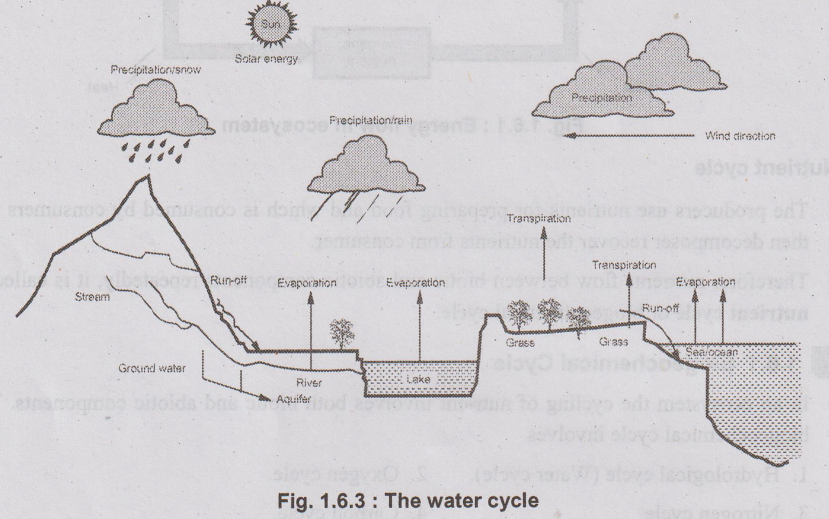
• Water is evaporated from the surfaces of
both water bodies and land surfaces. It is also transpired from living plant
cells.
•
The water vapour produced is circulated throughout the atmosphere, where it is
eventually precipitated as show and rain. Snow and rain are the ultimate
sources of all drinkable water.
4. Carbon Cycle
•
Carbon is an important element in all the bilogical or organic compounds. The
carbon is found in all biotic components in different forms as food.
Examples
:
Proteins, carbohydrates, fats and amino acids. .
•
In atmosphere, carbon dioxide (CO2) is present as carbon element.
The CO2 is removed by photosynthesis process of green plants.
•
The photosynthesis makes food for the plant. This food moves through food chain
and finally the carbon present in dead matter is returned to atmosphere as CO2.
Fig. 1.6.4 : Carbon cycle
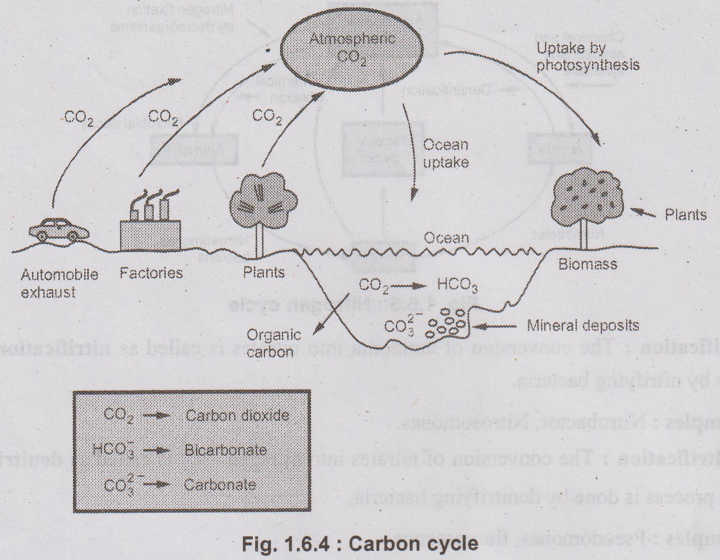
Sources
of CO2 in atmosphere
i)
Respiration of plants, animals and humans librates CO2, in
atmosphere.
ii)
Combustion of fuels releases CO2
iii)
Volcanic eruptions.
5. Nitrogen Cycle
•
Nitrogen and its compounds are essential for its life process in the biosphere.
•
Nitrogen gas (N2) comprises about 78 % of the atmosphere, still
plant growth is affected due to nitrogen, deficiency, agriculture quickly
deplets soil nitrogen, therefore fertilizers fulfills this deficiency.
•
The nitrogen is present in all biotic components in different forms as food.
Examples
:
Proteins, vitarriins, aminoacids etc.
•
There is continuous exchange nitrogen between atmosphere and plants which is
known as nitrogen cycle.
•
Fig. 1.6.5 illustrates nitrogen cycle.
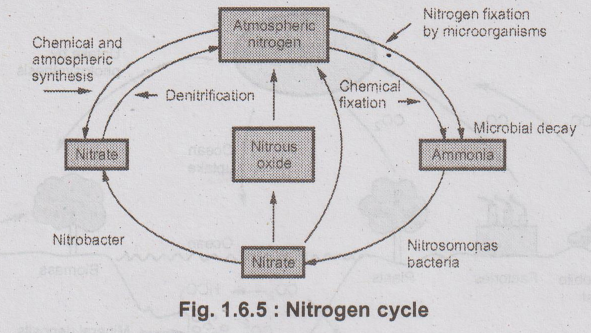
• Nitrification :
The conversion of ammonia into nitrates is called as nitrification. This is
done by nitrifying bacteria.
Examples
:
Nitrobactor, Nitrosomonas.
•
Denitrification : The conversion of nitrates into nitragen
(N2) is called as denitrification. This process is done by denitrifying
bacteria.
Examples
: Pseudomonas,
fluorescence.
6. Phosphorous Cycle
•
Phosphorus is found in rocks and fossils. It is present in all biotic
components in different forms.
Examples
:
Bones, teeths, guano deposits.
•
Phosphorus is excavated for fertilizer manufacturing. Farmers use excessive
fertilizers for crops.
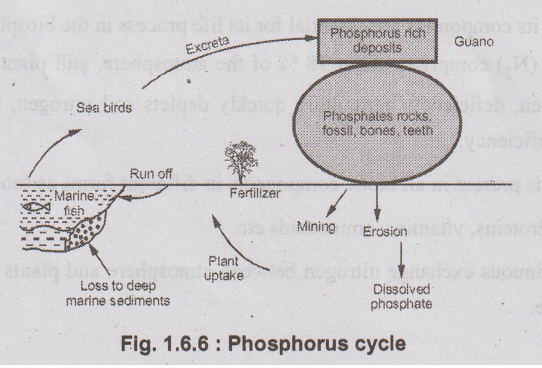
• This excess phosphate fertilizer move with
surface runoffs to ocean and lost into sediments. Sea birds eat fishes, which
are phosphorus rich and birds return phosphorus to land.
•
The sea birds are playing an important role in phosphorus cycling. Animals and
plants use phosphates during biosynthesis.
7. Photosynthesis
•
Photosynthesis is a complex redox process by which plants, algae and certain
bacteria, using the energy of sunlight, convert carbon dioxide and water into
carbohydrates (sugar) and dioxygen.
•
The catalysts used in plants are the chlorophyll pigments, carotenoids and the
phycoblins. These pigments absorb light and help to convert it into chemical
energy via the formation of new chemical bonds.
•
The overall reaction can be simply represented by,

•
Photosynthesis is the main way what foodstuffs are produced for the higher
animals, atmospheric dioxygen is replenished and energy obtained from the sun
is stored. Plants that can photosynthesis are therefore referred to as the
primary producers in the food chain.
•
All other organisms that feed on plants in order to use their organic compounds
in respiration and as an energy source are called consumers.
Review Questions
1. With a neat sketch
explain carbon cycle.
2. Explain energy flow
models in ecosystem.
3. With a neat sketch,
describe carbon cycle.
Environmental Sciences and Sustainability: Unit I: Environment and Biodiversity : Tag: : - Energy Flow in Ecosystem
Related Topics
Related Subjects
Environmental Sciences and Sustainability
GE3451 ESS 4th Semester | 2021 Regulation | 4th Semester EEE Dept 2021 Regulation
